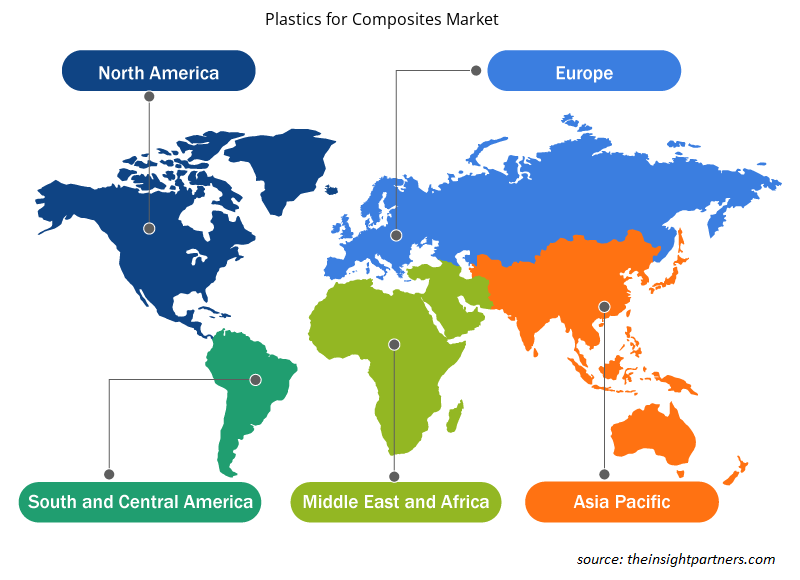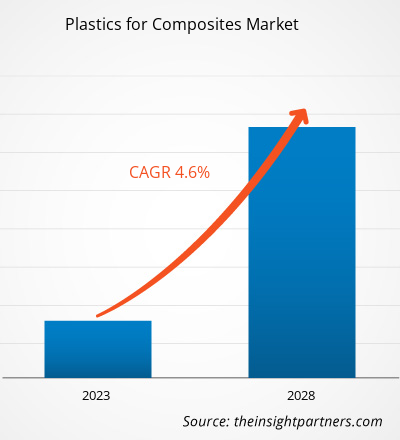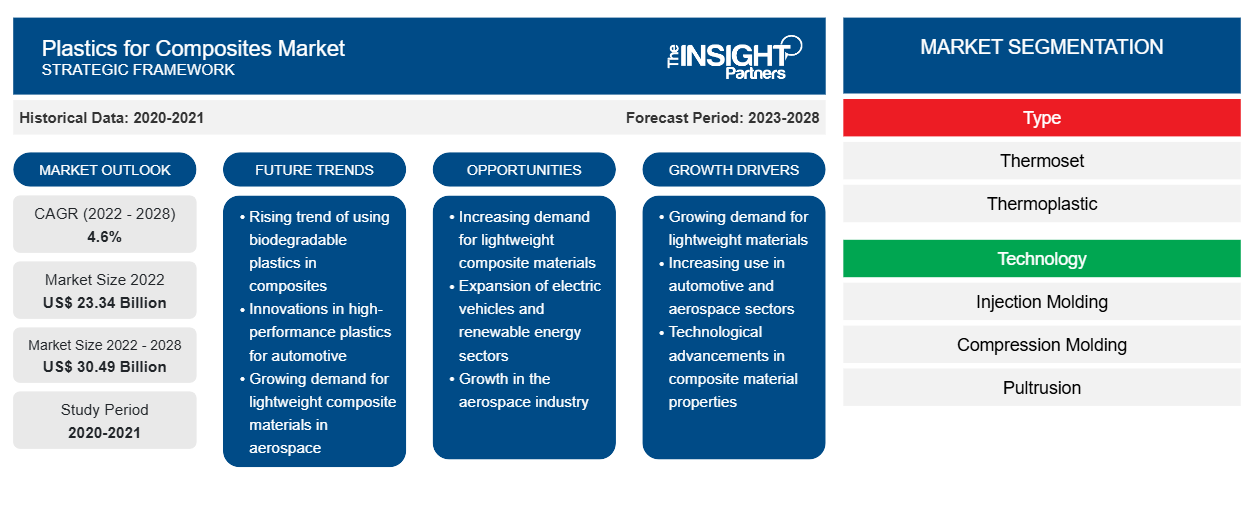Le marché des plastiques pour composites devrait passer de 23 337,24 millions USD en 2022 à 30 490,85 millions USD en 2028 ; il devrait enregistrer un TCAC de 4,6 % de 2022 à 2028.
Les composites sont des matériaux constitués de deux ou plusieurs phases chimiquement et physiquement différentes, séparées par une interface distincte. La plupart des composites produits commercialement utilisent un matériau de matrice polymère, souvent appelé solution de résine. Les matrices polymères couramment utilisées comprennent le polyester, l'ester vinylique, l'époxy, le phénolique, le polyimide, le polyamide, le polypropylène et le polyétheréthercétone (PEEK). Un faible coût, une facilité de traitement, une bonne résistance chimique et une faible densité sont parmi les principaux avantages associés aux matrices polymères.
L'utilisation croissante des résines composites dans les activités de construction et de bâtiment, ainsi que dans les applications aérospatiales et militaires, contribue à la croissance du marché des plastiques pour composites . En outre, la demande de matériaux légers dans la fabrication de véhicules, pour améliorer le rendement énergétique, est un autre facteur qui propulse l'expansion du marché. En outre, la demande croissante de résines thermoplastiques contribue de manière significative à la croissance globale du marché des plastiques pour composites. Des fibres rigides et une meilleure résistance à la chaleur, une résistance aux fissures, une résistance élevée aux chocs et une matrice polymère résistante sont les principales caractéristiques des composites polymères qui expliquent leur popularité. L'augmentation des investissements dans la production d'énergie renouvelable devrait déclencher la demande de composites polymères au cours des prochaines années.
Personnalisez ce rapport en fonction de vos besoins
Vous bénéficierez d'une personnalisation gratuite de n'importe quel rapport, y compris de certaines parties de ce rapport, d'une analyse au niveau des pays, d'un pack de données Excel, ainsi que d'offres et de remises exceptionnelles pour les start-ups et les universités.
-
Obtenez les principales tendances clés du marché de ce rapport.Cet échantillon GRATUIT comprendra une analyse de données, allant des tendances du marché aux estimations et prévisions.
Informations sur le marché
La demande croissante des industries automobile et aérospatiale stimule la croissance du marché des plastiques pour composites
La résine composite est utilisée dans diverses applications, notamment la construction et les infrastructures, les transports, l'électricité et l'électronique, l'énergie éolienne, les pipelines et les réservoirs, la marine, l'aérospatiale et l'armée. Les matériaux avancés sont essentiels pour augmenter l'économie de carburant des automobiles modernes tout en garantissant la sécurité et les performances. Comme il faut moins d'énergie pour accélérer des objets plus légers que des objets plus lourds, les matériaux légers offrent un excellent potentiel pour augmenter l'efficacité des véhicules. Par conséquent, la forte demande de composites de l'industrie automobile pour la fabrication de véhicules légers et économes en carburant stimule la croissance du marché des plastiques pour composites. Les industries d'utilisation finale des économies émergentes, telles que la Chine et l'Inde, sont les principaux contributeurs à la demande croissante de plastiques pour composites. Le besoin croissant de matériaux plus légers pour construire des composants et des pièces d'aviation a été un autre facteur important contribuant à la croissance du marché des plastiques pour composites. Les constructeurs aéronautiques s'efforcent d'agrandir les structures thermoplastiques primaires des jets d'affaires et des avions commerciaux. Ils ont été les premiers à adopter les thermoplastiques renforcés de fibres longues.
Informations sur les types
En fonction du type, le marché des plastiques pour composites est segmenté en thermodurcissables (polyester, ester vinylique, époxy, polyuréthane et autres) et thermoplastiques (polypropylène, polyéthylène, chlorure de polyvinyle, polystyrène, polyéthylène téréphtalate, polycarbonate et autres). Le segment des thermodurcissables détenait une part plus importante du marché en 2021. Le thermodurcissable est un matériau de matrice polymère populaire pour les composites renforcés de fibres. Les exemples courants de thermodurcissables comprennent les époxydes et les polyesters. Ils font partie des principaux types de systèmes matriciels, spécifiquement utilisés dans l'industrie aérospatiale. Les composites à matrice thermodurcissables sont plus largement utilisés que les composites à matrice thermoplastique en raison de leur viscosité plus faible à des températures relativement basses (moins de 100 °C), ce qui facilite mieux le processus de mouillage de la résine/fibre. Ces facteurs devraient stimuler la croissance du marché des composants à matrice thermodurcissable.
Lanxess AG, Covestro AG, Celanese Corp, INEOS Group Holdings SA, Daicel Corp, BASF SE, Evonik Industries AG, Solvay SA, Saudi Basic Industries Corp et Arkema SA comptent parmi les principaux acteurs du marché des plastiques pour composites. Les principaux acteurs adoptent des stratégies telles que les fusions et acquisitions et les lancements de produits pour étendre leur présence géographique et leur base de consommateurs. Par exemple, en juin 2022, Lanxess AG a lancé un composite à matrice polyamide 6 à base de cyclohexane « vert ».
Aperçu régional du marché des plastiques pour composites
Les tendances et facteurs régionaux influençant le marché des plastiques pour composites tout au long de la période de prévision ont été expliqués en détail par les analystes d’Insight Partners. Cette section traite également des segments et de la géographie du marché des plastiques pour composites en Amérique du Nord, en Europe, en Asie-Pacifique, au Moyen-Orient et en Afrique, ainsi qu’en Amérique du Sud et en Amérique centrale.

- Obtenez les données régionales spécifiques au marché des plastiques pour composites
Portée du rapport sur le marché des plastiques pour composites
| Attribut de rapport | Détails |
|---|---|
| Taille du marché en 2022 | 23,34 milliards de dollars américains |
| Taille du marché d'ici 2028 | 30,49 milliards de dollars américains |
| Taux de croissance annuel composé mondial (2022-2028) | 4,6% |
| Données historiques | 2020-2021 |
| Période de prévision | 2023-2028 |
| Segments couverts |
Par type
|
| Régions et pays couverts |
Amérique du Nord
|
| Leaders du marché et profils d'entreprises clés |
|
Densité des acteurs du marché des plastiques pour composites : comprendre son impact sur la dynamique commerciale
Le marché des plastiques pour composites connaît une croissance rapide, tirée par la demande croissante des utilisateurs finaux en raison de facteurs tels que l'évolution des préférences des consommateurs, les avancées technologiques et une plus grande sensibilisation aux avantages du produit. À mesure que la demande augmente, les entreprises élargissent leurs offres, innovent pour répondre aux besoins des consommateurs et capitalisent sur les tendances émergentes, ce qui alimente davantage la croissance du marché.
La densité des acteurs du marché fait référence à la répartition des entreprises ou des sociétés opérant sur un marché ou un secteur particulier. Elle indique le nombre de concurrents (acteurs du marché) présents sur un marché donné par rapport à sa taille ou à sa valeur marchande totale.
Les principales entreprises opérant sur le marché des plastiques pour composites sont :
- Lanxess SA
- Covestro SA
- Celanese Corp
- INEOS Group Holdings SA
- Daicel Corp
Avis de non-responsabilité : les sociétés répertoriées ci-dessus ne sont pas classées dans un ordre particulier.

- Obtenez un aperçu des principaux acteurs du marché des plastiques pour composites
Rapports en vedette
- Tendances progressistes dans l'industrie des plastiques pour composites pour aider les acteurs à développer des stratégies efficaces à long terme
- Stratégies de croissance commerciale adoptées par les entreprises pour assurer leur croissance sur les marchés développés et en développement
- Analyse quantitative du marché mondial des plastiques pour composites de 2020 à 2028
- Estimation de la demande en matières plastiques pour composites dans diverses industries
- Analyse des cinq forces de Porter pour illustrer l'efficacité des acheteurs et des fournisseurs opérant dans l'industrie des plastiques pour composites
- Développements récents pour comprendre le scénario concurrentiel du marché et la demande de plastiques pour composites
- Tendances et perspectives du marché et facteurs régissant la croissance du marché des plastiques pour composites
- Des stratégies éclairantes qui soutiennent l'intérêt commercial concernant la croissance du marché, aidant au processus de prise de décision
- Taille du marché des plastiques pour composites à différents nœuds du marché
- Aperçu détaillé et segmentation du marché, ainsi que de sa dynamique sectorielle
- Taille du marché des plastiques pour composites dans diverses régions avec des opportunités de croissance prometteuses
Français L'« Analyse du marché des plastiques pour composites jusqu'en 2028 » est une étude spécialisée et approfondie de l'industrie des produits chimiques et des matériaux, axée sur l'analyse des tendances du marché des plastiques pour composites. Le rapport vise à fournir un aperçu du marché avec une segmentation détaillée. Le marché des plastiques pour composites est segmenté en fonction du type, de la technologie et de la géographie. En fonction du type, le marché est segmenté en thermodurcissable (polyester, ester vinylique, époxy, polyuréthane et autres) et thermoplastique (polypropylène, polyéthylène, polychlorure de vinyle, polystyrène, polyéthylène téréphtalate, polycarbonate et autres). En fonction de la technologie, le marché est segmenté en moulage par injection, moulage par compression, pultrusion, infusion de résine et autres. En termes de géographie, le marché est segmenté en cinq régions principales : l'Amérique du Nord, l'Europe, l'Asie-Pacifique, le Moyen-Orient et l'Afrique, et l'Amérique du Sud et l'Amérique centrale. En 2021, l'Asie-Pacifique a dominé le marché des plastiques pour composites. La région devrait enregistrer le TCAC le plus élevé du marché au cours de la période de prévision. Les secteurs de l'automobile et de la construction en Asie-Pacifique connaissent une croissance rapide. C'est la région la plus peuplée du monde et elle abrite l'un des secteurs de la construction qui connaît le développement le plus rapide au monde. Ces facteurs contribuent à une forte demande de plastiques pour les composites en Asie-Pacifique.
- Analyse historique (2 ans), année de base, prévision (7 ans) avec TCAC
- Analyse PEST et SWOT
- Taille du marché Valeur / Volume - Mondial, Régional, Pays
- Industrie et paysage concurrentiel
- Ensemble de données Excel
Rapports récents
Rapports connexes
Témoignages
Raison d'acheter
- Prise de décision éclairée
- Compréhension de la dynamique du marché
- Analyse concurrentielle
- Connaissances clients
- Prévisions de marché
- Atténuation des risques
- Planification stratégique
- Justification des investissements
- Identification des marchés émergents
- Amélioration des stratégies marketing
- Amélioration de l'efficacité opérationnelle
- Alignement sur les tendances réglementaires























 Obtenez un échantillon gratuit pour - Marché des plastiques pour composites
Obtenez un échantillon gratuit pour - Marché des plastiques pour composites